The design of steel pipe piling
Steel pipe pile foundation has the characteristics of quick construction, safety and highly mechanized operation, and is often widely used in large offshore bridges, substructures of ports and wharves, temporary platforms and trestles, etc. Compared with reinforced concrete foundation, steel tube pile foundation has the following advantages:
- Lightweight, high strength, convenient loading and transportation;
- High bearing capacity. The steel can be effectively driven into the hard soil and the pile body is not easy to damage and can obtain a great single pile bearing capacity;
- The length is easy to adjust, can be adjusted by connecting or cutting according to the need.
- A small amount of soil discharge. The lower end of the pile is open. With the driving of the pile, the soil squeezing volume of the pile pipe is greatly reduced compared with that of the solid core concrete pile, and the disturbance to the surrounding foundation is less and the displacement is less.
- It can be welded, easy to operate and fast to construct.
Steel pipe piles are generally made of plain carbon steel, with a tensile strength of 402MPa and yield strength of 235.2MPa, or according to the design requirements. It can be an SSAW pipe and an LSAW pipe. SSAW steel pipe has high rigidity and is commonly used. In order to facilitate transportation and be limited by pile frame height, steel pipe piles are usually composed of an upper section pile, a lower section pile and several middle section piles respectively. The length of each section is generally 13m or 15m, as shown in the figure:
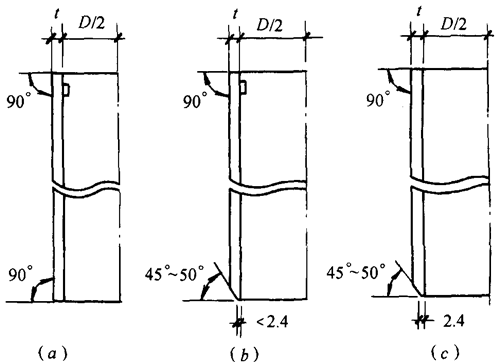
A) Lower section pile;
(b) Mid-section pile;
(c) Upper section pile
The lower end of the steel pipe pile is divided into opening and closing. Its structure and type are shown in the figure below:
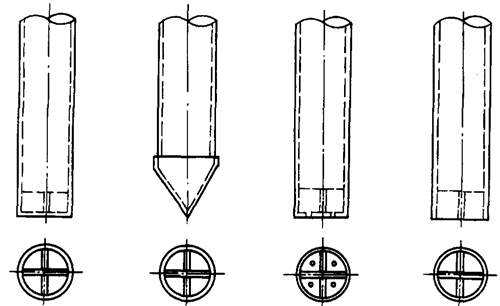
The diameter of the steel pipe pile is φ406.4-φ2032.0mm, and the wall thickness is 6-25mm.
We should take the engineering geology, load, foundation plane, upper load and construction conditions into consideration. Commonly used specifications are 406.4mm, 609.6mm and 914.4mm, wall thickness 10, 11, 12.7, 13mm, etc. Generally, upper, middle and lower section piles usually adopt the same wall thickness. Sometimes, in order to make the pile top bear the huge hammer impact and prevent the radial instability, the wall thickness of the upper section of the pile should be appropriately increased, or a flat steel reinforcement collar 200~300mm wide and 6~12mm thick should be added to the outer ring of the pile pipe. In order to reduce the friction resistance of the pile pipe sinking and prevent the end from being damaged due to deformation when penetration into the hard soil layer, a strengthening collar is also set at the lower end of the steel pipe pile. For Φ406.4 ~ Φ914.4mm steel pipe, the size of the strengthening pipe collar is 200~300mm*6~12mm.
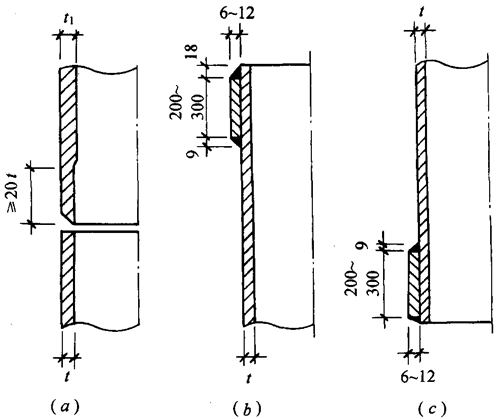
(a) Structural forms of steel tube pile joints with different wall thicknesses;
(b) Reinforcement collar on top of piles;
(c) Reinforcement collar at the lower end of the pile
The accessories of steel pipe piles mainly include a pile cover welded on top of the pile for bearing the upper load, flat steel strip, a protective ring at the bottom of the pile, and a copper clamp welded on the pile joint. In order to reduce the negative friction of soft soil foundation on the bearing capacity of piles, a layer of special asphalt, polyethylene and other composite materials are coated on the outer surface of the upper end of the steel pipe pile to form a sliding layer of 6~10mm, reducing the negative friction by 4/5-9/10.
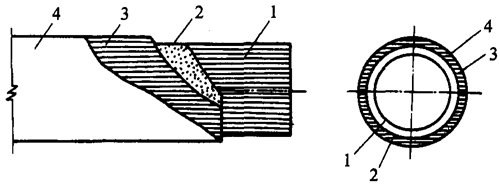
Structure of sliding layer of steel pipe pile:
1 Steel pipe pile;
2 Primer coating;
3 Sliding layer;
4 Surface

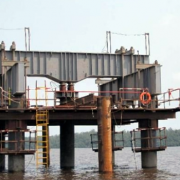
Leave a Reply
Want to join the discussion?Feel free to contribute!